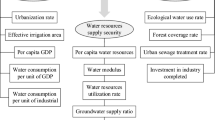Abstract
Flood and drought coexist in many river basins, thus analyses of water resource compensation characteristics become important, since they are the foundation for rational utilization of floodwaters. In this research, set pair analysis (SPA), a relatively new uncertainty analysis method, is used to study the dry and wet compensation characteristics of water resource parameters. In addition, fuzzy membership and grey correlation degree are adopted to test the result of set pair analysis. The Dongjiang River is taken as an example and the analyzed parameters include precipitation and mean discharge from different hydrological stations. The results show that there is a high homeotype-encountering chance for precipitation and mean discharge between different stations for both dry and wet conditions; thus the compensation capacity is small. Although the mean discharge is synchronous with the precipitation in the river basin, there exists a certain degree of shift, indicating possible utilization of floodwater on a small scale. The results from SPA are consistent with that from a traditional analysis method, showing that SPA is a promising alternative method for studying river basin water resource compensation characteristics, in particular for exploring potential complements embedded in noncomplementary general features.
Similar content being viewed by others
References
Al-Houri Z M, Barber M E (2011). Assessment of the SCS-CN initial abstraction ratio during rain-on-snow events. Fresenius Environmental Bulletin, 20(9): 2391–2399
Alvisi S, Bernini A, Franchini M (2013). A conceptual grey rainfallrunoff model for simulation with uncertainty. Journal of Hydroinformatics, 15(1): 1–20
Alvisi S, Franchini M (2012). Grey neural networks for river stage forecasting with uncertainty. Phys Chem Earth, 42–44: 108–118
Davis M D (2007). Integrated Water resource management and water sharing. J Water Resour Plan Manage, 133(5): 427–445
Deng H X, Li C J, Zhang S W (2006a). The choice method of similar reaches based on set pair analysis. Yellow River, 28(7): 3–4 (in Chinese)
Deng H X, Li C J, Zhu B (2006b). Analysis of regularity of runoff distribution of main rivers in upper reaches of Yangtze River. Sichuan Water Power, 25: 76–78 (in Chinese)
Deng J (2002). Grey Forecasting and Decision. Wuhan: Huazhong University of Science and Technology Press, 79–81 (in Chinese)
Feng L H, Zhang X C, Gong J L (2004). Statistical forecast of change tendency of water resources based on the set pair analysis. Hydrology, 23(2): 11–14 (in Chinese)
Fleiner T (2001). Note-uncrossing a family of set-pairs. Combinatorica, 21(1): 145–150
Gallant A J E, Kiem A S, Verdon-Kidd D C, Stone R C, Karoly D J (2012). Understanding hydroclimate processes in the Murray-Darling Basin for natural resources management. Hydrol Earth Syst Sci, 16(7): 2049–2068
Karmakar S, Mujumdar P P (2007). A two-phase grey fuzzy optimization approach for water quality management of a river system. Adv Water Resour, 30(5): 1218–1235
Kiem A S, Franks S W (2004). Multi-decadal variability of drought risk, eastern Australia. Hydrol Processes, 18(11): 2039–2050
Kiem A S, Verdon-Kidd D C (2010). Towards understanding hydroclimatic change in Victoria, Australia — Preliminary insights into the ‘Big Dry’. Hydrol Earth Syst Sci, 14(3): 433–445
Kirono D G C, Chiew F H S, Kent D M (2010). Identification of best predictors for forecasting seasonal rainfall and runoff in Australia. Hydrol Processes, 24(10): 1237–1247
MacDonald D H, Morrison MD, Barnes MB (2010). Willingness to pay and willingness to accept compensation for changes in urban water customer service standards. Water Resour Manage, 24(12): 3145–3158
Mehta V M, Rosenberg N J, Mendoza K (2011). Simulated impacts of three decadal climate variability phenomena on water yields in the Missouri River basin. J Am Water Resour Assoc, 47(1): 126–135
Stakhiv E Z (2003). Disintegrated water resources management in the U.S.: union of Sisyphus and Pandora. J Water Resour Plan Manage, 129(3): 151–154
Rientjes T, Haile A T, Fenta A A (2013). Diurnal rainfall variability over the Upper Blue Nile Basin: a remote sensing based approach. Int J Appl Earth Obs Geoinf, 21: 311–325
van Ogtrop F F, Vervoort RW, Heller G Z, Stasinopoulos D M, Rigby R A (2011). Long-range forecasting of intermittent streamflow. Hydrol Earth Syst Sci, 15(11): 3343–3354
Wan X, Wang WS, Ding J (2006). Set pair analysis and its application to hydrology and water resources. Advances in Science and Technology of Water Resources, 26(4): 9–11 (in Chinese)
Wooldridge S A, Kalma J D, Franks S W, Kuczera G (2002). Model identification by space-time disaggregation: a case study from eastern Australia. Hydrol Processes, 16(2): 459–477
Zhao K Q (2000). Set Pair Analysis and Its Primary Application. Hangzhou: Zhejiang Science and Technology Press, 86–88 (in Chinese)
Author information
Authors and Affiliations
Corresponding author
Rights and permissions
About this article
Cite this article
Chen, Q., Li, J., Li, R. et al. River basin water resource compensation characteristics by set pair analysis: the Dongjiang example. Front. Earth Sci. 8, 64–69 (2014). https://doi.org/10.1007/s11707-013-0389-4
Received:
Accepted:
Published:
Issue Date:
DOI: https://doi.org/10.1007/s11707-013-0389-4




